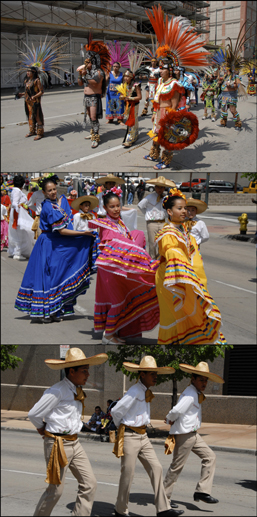Cinco de Mayo
Cinco de Mayo, the 5th of May in Spanish, is a Mexican regional holiday that, within Mexico, is celebrated primarily in the state of Puebla and the federal district but is also observed in other parts of Mexico. It has become a popular celebration of Mexican heritage in areas where the Mexican diaspora live, and because of this people sometimes mistakenly assume that it marks the date of Mexican independence. In reality, Mexican independence is celebrated on September 16 while Cinco de Mayo commemorates a later battle and victory by Mexican forces against a significantly larger force of French invaders at the city of Puebla on May 5th, 1862.
The Battle of Puebla
For more information, see the full article: Battle of Puebla
Benito Juárez was installed as president of Mexico at the beginning of 1861 following the conclusion of the War of Reform. Upon coming into office, Juárez found his government faced with imminent bankruptcy, and in July of 1861, he announced that all payments would be suspended on the substantial debt that the Mexican government owed to Spain, France, and England. In response, the lending nations made plans to seize the customs house at the port of Veracruz; Spanish troops arrived arrived at the close of 1861 followed closely by troops dispatched from England and France.
The Mexican government negotiated a withdrawal of the Spanish and English forces in the spring of 1862, but the French boldly declared their intention to establish a monarchy in Mexico, and while disclaiming any hostile intentions against the people, issued a proclamation inviting all who were friendly to their cause to rally around them. To that end, French troops were ordered to march on Mexico City. On May 4th a force of some 6,000 French cavalry and infantry commanded by General Lorencez made camp outside of the city of Puebla, midway between Veracruz and the capital.
The French encountered significant resistance at Puebla. There, Mexican General Ignacio Zaragoza addressed his commanders, representing to them the danger menacing their country and the disgrace of allowing an invading army, however formidable, to advance unchecked on the capital. "If we cannot defeat them, we can at least cripple them," he argued. Zaragoza's troops sustained heavy casualties in the skirmishes fought during the course of the day on the 5th but succeeded in holding off the French army, which retreated on the 8th after Zaragoza was reinforced.
The French eventually regrouped and launched a second campaign the following year with more than 25,000 troops. This effort met with more success and the army reached Mexico City in June of 1863. Maximilian of Hapsburg was installed as emperor of Mexico in April of 1864 but his reign was short, lasting only until 1867 after Napoleon III withdrew his support and the Republicans retook Chapultepec Castle.
President Juárez declared Cinco de Mayo a national holiday in the fall of 1862 on the anniversary of the Grito de Dolores. The Battle of Puebla became a symbol of Mexico's ability to defend itself against foreign aggression. Following on the heels of the Mexican-American War, which resulted in the loss of nearly half of Mexico's national territory to the United States, the victory at Puebla over one of the world's most elite military forces, "became a testimonial manifesto of patriotism and pride in Mexican identity and nationhood."[1]
Observance
Mexican celebrations of Cinco de Mayo are mainly limited to the areas surrounding Puebla and Mexico City. Early celebrations are not well documented but one description does exist for a reconstruction that was staged in Peñón near Mexico City in 1933.[2] Celebrations are much more widespread in the United States among the Mexican diaspora than in Mexico itself.
United States
Cinco de Mayo celebrations became increasingly common in the United States at the end of the 20th century. A survey conducted in 1998 cataloged 120 celebrations dispersed over 21 states.[2]
References
- ↑ Rafaela G. Castro. 2001. Chicano Folklore: A Guide to the Folktales, Traditions, Rituals and Religious Practices of Mexican Americans. Oxford: Oxford University Press. Pp. 56.
- ↑ 2.0 2.1 Alvar W. Carlson. 1998. America's Growing Observance of Cinco de Mayo. Journal of American Culture 21(2): 7-16.
Notice: Portions of this article are sourced from History of Mexico: Being a Popular History of the Mexican People from the Earliest Primitive Civilization to the Present Time, a work by Hubert Howe Bancroft that is now in the public domain because its copyright has expired.
